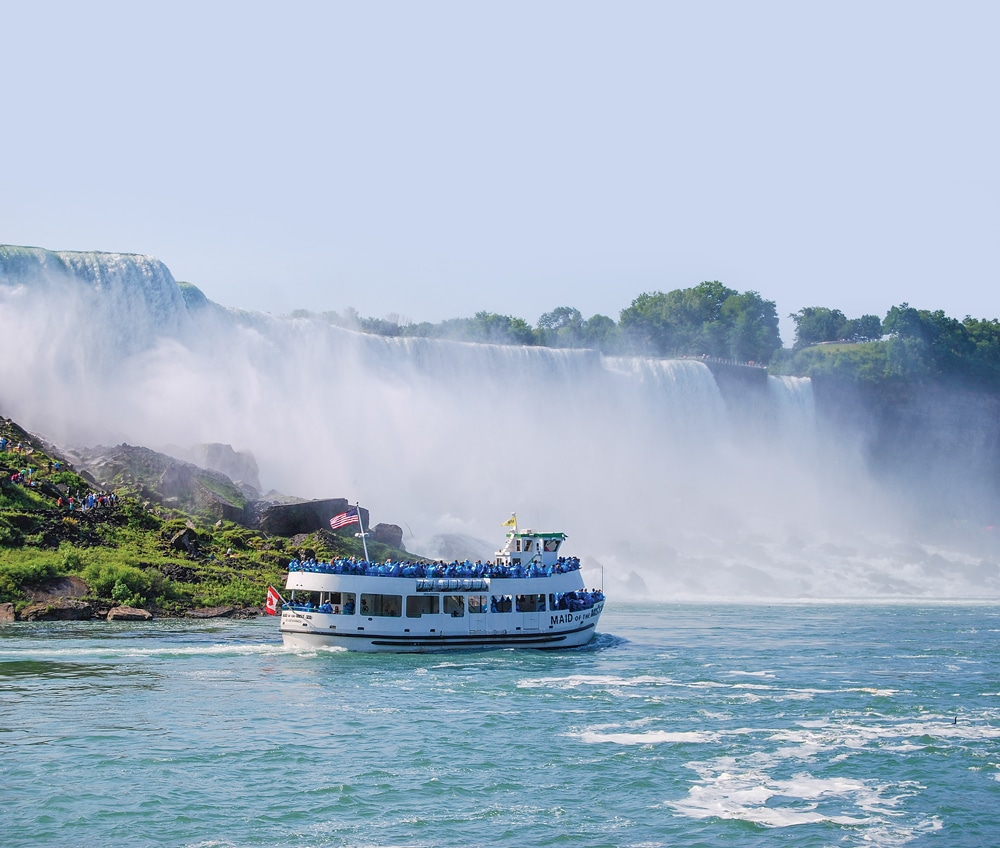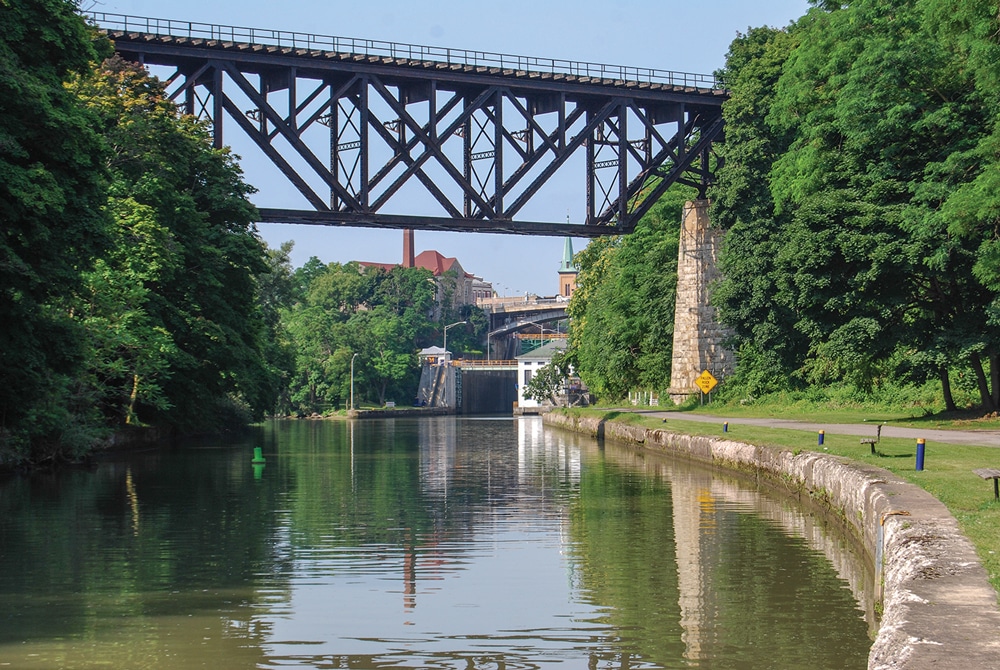One of North America’s most famous natural wonders is just dripping with adventure
Remember begging your mom and dad to let you run through the lawn sprinklers on hot summer days? During a sultry spell last July, I  was ready to indulge my inner child in the mother of all water parks as my husband, Bob, and I aimed our Class B Sprinter motorhome toward New York state. Our destination was America’s oldest state park, established at Niagara Falls in 1885, and our plan was to have fun.
was ready to indulge my inner child in the mother of all water parks as my husband, Bob, and I aimed our Class B Sprinter motorhome toward New York state. Our destination was America’s oldest state park, established at Niagara Falls in 1885, and our plan was to have fun.
Arriving at the park just before 9 a.m., Bob nabbed a shady parking space for the motorhome in the state park’s lot No. 1. Since we were staying at a New York state campground, parking was free, instead of the usual $10 daily fee, so we skipped past solicitors trying to wave drivers into pricey commercial parking.

Wearing blue plastic ponchos, passengers on the Maid of the Mist spend 20 wet minutes cruising close to the American, Bridal and Horseshoe falls.
At the park’s visitor center we bought Discovery Passes for admission to multiple attractions, saving money and time versus buying tickets separately. (Entrance to the state park itself is free.) Our priorities were set: Bob wanted to see the Cave of the Winds, and I had heard of the iconic Maid of the Mist all my life.
Back in 1846, travelers boarded a steamboat ferry to cross the Niagara River. After a bridge was built two years later, the boat turned into the Maid of the Mist tourist attraction that has endured in various guises, from wooden paddlewheel steamers to today’s 80-foot, 300-passenger diesel-powered boats. Reservations aren’t taken since boats depart every 15 minutes to give visitors a close-up look at the three falls that make up Niagara Falls.
We followed signs beyond the visitor center, exchanged tabs from our passes for tickets, and rode the Observation Tower elevator down to the landing. Staff members there handed us thin blue ponchos (think drycleaner bags with drawstring hoods), and within minutes our boat departed the dock. Along with everyone else on board, we dutifully donned our rainwear, put our cameras into baggies and found a place by a rail.
As our sturdy craft approached the rocky base of the American Falls, mist turned to spray and we looked up at 75,000 gallons of water per second cascading in our direction. The “Maid” cruised past Bridal Veil Falls and continued on toward Horseshoe Falls on the Canada side. The wind came up, hoods flew off and blue plastic billowed above our waists. Talking was impossible as water thundered down from three sides, so we laughed instead. Cruising back to the dock, we watched seabirds fly through rainbows that formed as sunlight hit the mists.
 We squished off the boat, tossed our ponchos into recycling bins and found a bench to dry out in the sun before riding the elevator back up to the top of the Observation Tower. We lingered awhile to take photos, since the 282-foot tower extends over Niagara Gorge for panoramic views of all three falls.
We squished off the boat, tossed our ponchos into recycling bins and found a bench to dry out in the sun before riding the elevator back up to the top of the Observation Tower. We lingered awhile to take photos, since the 282-foot tower extends over Niagara Gorge for panoramic views of all three falls.
Back at the visitor center, we took a break in an air-conditioned theater to watch the park’s half-hour action movie included in our passes, “Niagara: Legends of Adventure.” We absorbed a quick history from Native American settlers to modern-day daredevils who have gone over in a barrel or crossed on a wire. But we didn’t pause to browse the gift shop – we were there to see more of the magnificent falls waiting right outside.
We trotted toward a trolley stop, admiring the layout of footpaths and gardens designed by America’s first landscape architect, Frederick Law Olmsted, who also created New York City’s Central Park. Much of what we saw appeared new, evidence of a $25 million makeover plan the state adopted for Niagara State Park in 2012 and continues to implement.
Our destination was Goat Island, reached via either a pedestrian or vehicular bridge. We rode the vintage-style trolley to a stop in front of the Top of the Falls Restaurant, which sports a view of Horseshoe Falls, and chose seating up on a canvas-shaded outdoor terrace.
 |
 |
Fortified by burgers and frozen drinks, we crossed a pedestrian bridge onto little Luna Island, which reopened in 2013 after its restoration. The island perches atop the edge of the spillway, and river water rushes past it on both sides, plunging down to the gorge to form Bridal Veil Falls on the west side of the island and the American Falls to the east.
Peering over the railing to the base of Bridal Veil Falls, we could see tiny figures through the mist below, swathed in yellow versions of our morning’s blue raingear. We decided to join them and, at the Cave of the Winds entrance on Goat Island, surrendered another set tab from our Discovery Passes. A staff member requested our shoe sizes and supplied green-and-blue souvenir sandals with ribbed soles made of sturdy plastic foam. (Tip: If you go to the Cave of the Winds first, your feet will be suitably outfitted for riding the Maid of the Mist, too.)
Wearing our jaunty footwear, we stuffed street shoes into staff-provided plastic bags, took another elevator ride 175 feet down into the gorge and donned our yellow ponchos. Gripping handrails, we followed a series of red-painted, wet, wooden walkway levels leading up numerous stairs, ever closer to the Hurricane Deck. Finally, we stood in tropical stormlike wind and water, not in a true cave, but about 20 feet from thundering Bridal Veil Falls. It was a dramatic way to feel Niagara’s power at the closest falls encounter in the park.
The towpath along the Erie Canal at Lockport, New York, once trod by barge-pulling mules, now offers visitors a shady spot for a stroll.

The towpath along the Erie Canal at Lockport, New York, once trod by barge-pulling mules, now offers visitors a shady spot for a stroll.
On the elevator ride back up, an employee told us that carpenters take down the walkways each November to prevent winter storm damage, and reassemble them every spring. Soggy and satisfied with our day of fun in the sun, we rode the trolley back to the parking lot and drove 20 minutes north on the Robert Moses State Parkway to our campsite.
The Four Mile Creek State Campground on Lake Ontario bustled with camping families during our four-night stay. Part of the State of New York Parks system, the campground has 275 sites (130 with electric hookups, some with 50-amp service), fire rings, hot showers, flush toilets and laundry facilities as well as water fill-up spigots and a dump station. Pets are permitted and campers are asked to show proof of rabies inoculation.
After supper, Bob built a fire and we discussed the next day’s plans. We had our passports, so why not visit Niagara Falls, Canada, too? So Saturday morning, under threatening skies, we drove south again, pausing to inspect two other state parks by the parkway, both with hiking and nature trails down to the Niagara Gorge level. At Devil’s Hole State Park we could see the lower rapids, and at Whirlpool State Park, overlooks provided us with views of a whirlpool created by the abrupt bend in the Niagara River below.
Back at Niagara State Park lot No. 1, we saw signs for a walkway to the Rainbow Bridge that links the U.S. and Canada for pedestrians and vehicles. Cars were at a standstill, so we left the motorhome parked and simply walked into Canada within minutes after only the briefest of border formalities. (Note: U.S. citizens must present a valid U.S. passport or NEXUS/FAST card at the border.)

Three historic flags commemorate the nations that have held Fort Niagara, New York, on Lake Ontario since 1726.
On the other side, strolling landscaped plazas by the river, we could appreciate the full breadth of the American and Bridal Veil falls, and of the rocky base where water pounds with 280 tons of force. We saw Horseshoe Falls again, where it hits the base with 2,509 tons of force, but from a different angle. And just as on the U.S. side, cruise boats left the Canada side to approach the falls, but with a difference – Hornblower Niagara Cruise ponchos were maple-leaf red.
As rain started falling, we ducked indoors for coffee and talked about a return trip someday to investigate the Canada side more fully. We had noticed the 775-foot Skylon Tower, with observation decks and a revolving dining room, a promising spot for viewing fireworks or the colorful nightly falls illumination on a clear evening.
Unexpected discoveries always make an RV trip more fun. Just a short ride from our campground the next morning, we found Old Fort Niagara State Park on a bluff above Lake Ontario, guarding the entrance to the Niagara River as it has since 1726. Costumed re-enactors explained that the fort’s key Great Lakes location gave it a critical role in the French and Indian War, the American Revolution and the War of 1812.

About 20 minutes north of Niagara Falls, costumed interpreters at Old Fort Niagara provide tours and musket demonstrations.
At the visitor center, we admired an enormous artifact on display: the actual 15-star, 15-stripe American flag that flew here during the War of 1812. Taken as a war trophy by the British in 1813, the flag spent 170 years in a Scottish castle until its return in 1994. We covered our ears for a musket-firing demonstration, and walked through restored stone structures, including the impressive 1726 “French Castle,” North America’s oldest building in the Great Lakes region.
Our second unexpected find was the historic canal town of Lockport, New York, less than 30 miles from Niagara Falls. We parked our motorhome at the Erie Canal Discovery Center and picked up a National Park Service brochure about the 363-mile-long public engineering feat. Built between 1817 and 1825, the Erie Canal was the first all-water link between the Great Lakes and the Atlantic Seaboard.
We looked down upon the canal’s electric-powered Barge Locks 34 and 35 that still displace more than 2.7 million gallons of Lake Erie water while locking boats through a 60-foot difference in elevation. Parallel to these functioning locks, restoration was finishing for two of the original Lockport “Flight of Five” locks. Dormant since the early 20th century, the two now function with 1842-style wooden lock gates and balance beams.
Falls Facts: An astonishing 3,160 tons of water flows over Niagara Falls every second. This accounts for 75,750 gallons of water per second over the American and Bridal Veil falls and 681,750 gallons per second over Horseshoe Falls.
We parked the motorhome below the locks, strolled along the towpath where mules once pulled barges, and waved to passengers onboard the “Lockview V” headed toward Lock 34 to begin their two-hour cruise.
Our final discovery was the Niagara Wine Trail linking 20 wineries. Local soils and the microclimate of the Niagara Escarpment protected by Lake Ontario create ideal conditions for growing grapes. On our last afternoon before heading south, we stopped into Schulze Vineyards & Winery close to our campground to taste samples and buy a few bottles of a wine we liked to take home.
Historic sites, a great American waterway and welcoming wineries all added up to a bonus at the end of our vacation. But like two oversize kids in plastic ponchos, we still thought the best part of Niagara Falls was getting wet on purpose. We had great memories – and plastic sandals – to take home.
For More Information

New York’s popular Four Mile Creek State Campground has 50-amp electric sites and is located 15 miles north of Niagara Falls.
Erie Canal
www.eriecanalway.org
Four Mile Creek State Park
716-745-3802
www.nysparks.com/parks/6/details.aspx
Lockport Locks
800-378-0352
www.lockportlocks.com
Niagara Falls State Park
716-278-1796
www.niagarafallsstatepark.com
The Niagara Wine Trail
www.niagarawinetrail.org
Old Fort Niagara
716-745-7611
www.oldfortniagara.org


